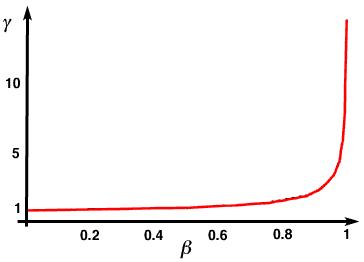Beta and Gamma
As the calculation of time dilation has
shown, the factor $\gamma$
plays a prominent role. It thus pays to take a look at the behavior
of $\gamma$ as a function of the speed v, or
equivalently as a function of the ratio $\beta$
of the speed relative to the speed of light,

The speed of light, c, is given by:
|
c
|
= 2.9979 $\cdot$ 108 m/s
= 299 790 000 km/s
= 186 320 000 miles/second
|
It is very instructive to plot $\gamma$as a
function of $\beta$. This is done in the plot
below. For speeds that are small compared to the speed of light,
$\beta$ is very small, approximately equal to 0.
In that case, $\gamma$ is very close to the value
1. However, as $\beta$ approaches 1,
$\gamma$
diverges, that
is to say grows larger and larger towards infinity.

There is also a useful
approximation that is
valid for low speeds. In
that case v is small compared to c and therefore $\beta$
is small compared to 1, and we can approximate $\gamma$
as:
$\gamma$ 1 +
1 +  $\beta$2
$\beta$2
(for $\beta$ small compared to 1)
©
MultiMedia Physics
2000


